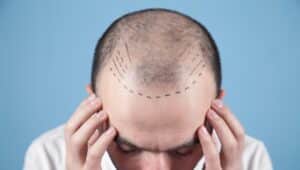If you recently underwent a hair transplant procedure at Cosmedica, you might wonder how to best protect your transplanted hair. You might also ask yourself how to ensure optimal results from your surgery. One key element after a hair transplant is wearing the right type of hat how to wear it properly.
This blog post discusses the importance of wearing a hat in the days following a hair transplant. It also offers tips and recommendations for choosing and wearing a hat during the recovery process.
Why should I cover my head after a hair transplant?
There are several reasons why it is important to cover your head after a hair transplant procedure.
Here are a few key reasons:
- To protect your implanted hairs: After a hair transplant, your implanted hairs are still in the delicate phase of recovery. They are more vulnerable to damage. By wearing a hat, you can help to protect your transplanted area from the sun, wind, and other environmental factors that could potentially harm it.
- To avoid infection: Wearing a hat can also help to reduce the risk of infection in the donor area (the area from which hair follicles are taken for transplantation). This is especially important if you have undergone a FUE (follicular unit extraction) hair transplant. Indeed, the donor area may be more vulnerable to infection due to the numerous small incisions made during the procedure.
- To reduce scarring: Covering your head can also help to reduce the appearance of scarring in the donor area. This is especially important if you have undergone a strip harvesting procedure. This type of hair transplant can result in a larger scar in the donor area. By wearing a hat, you can help to keep the scar covered and reduce the risk of developing keloid scars.
What type of hat should I wear after a hair transplant?

When choosing a hat to wear after a hair transplant, there are a few key factors to consider. Here are some tips for selecting the right type of hat:
- Wear a loose hat: It is important to choose a hat that is loose enough. It will allow you to not put too much pressure on your implanted hairs or the donor area. Avoid fitting hats that are too tight or that squeeze your head. Indeed, they can cause discomfort and potentially harm your transplanted grafts. You should, on the contrary, opt for a loose fitting hat.
- Choose a soft fabric: Opt for a hat made of soft, breathable fabric to avoid irritation and discomfort on your scalp. This is especially important if you are prone to sensitive skin or if you have a tendency to get dandruff.
- Avoid hats with rough or scratchy materials: These hats can potentially irritate your scalp and cause discomfort.
- Consider the type of hat: Depending on the type of hair transplant procedure you have undergone, you may want to consider different types of hats. For example, if you have undergone a strip harvesting procedure, you may want to avoid hats that have a tight band or brim. Indeed, they could potentially put pressure on the scar in the donor area. If you have undergone a FUE hair transplant, you may want to avoid hats that have a very tight fit. These ones could potentially irritate the small incisions made during the procedure.
Hats Provided by Cosmedica After a Hair Transplant
At Cosmedica, we understand the importance of protecting your implanted hairs and the donor area after a hair transplant. That’s why we provide a bucket hat for our patients to wear during the recovery process.
Our hats are made of soft, breathable fabric and are designed to be worn comfortably and gently on the scalp. If you have any questions or concerns about wearing a hat post hair transplant, our team of experienced professionals is always here to help.
How should I wear a hat after a hair transplant?

Once you have chosen a hat that is suitable for your hair transplant recovery, it is important to wear it properly. This will prevent damaging your implanted hair or the donor area. Here are some tips for wearing a hat after a hair transplant:
- Wear a cap: If you are wearing a cap, make sure to adjust it so that it is not too tight or too loose. You should also make sure that the cap does not cover the donor area or the implanted grafts. Indeed, this could potentially cause irritation or damage.
- Avoid wearing a hat too often: While it is important to protect your implanted hairs and the donor area after a hair transplant, it is also important to avoid wearing a hat too often. Overuse of a hat can lead to sweating and irritation on the scalp. This could potentially harm your transplanted hair follicles.
- Take breaks from wearing a hat: If you need to wear a hat for an extended period of time, make sure to take breaks and remove the hat every few hours to allow your scalp to breathe. This will help to prevent sweating and irritation on the scalp.
- Be gentle when removing and replacing your hat: When removing or replacing your hat, be gentle and avoid tugging or pulling on your hair or the donor area. This will help to prevent any accidental damage to your implanted hair grafts or the donor area.
Conclusion
Wearing a hat after a hair transplant is an important part of the recovery process. By choosing the right type of hat and wearing it properly, you can help to protect your implanted hairs and the donor area, reduce the risk of infection and scarring, and ensure the best possible results from your hair transplant surgery.
If you have any questions or concerns about wearing a hat after your hair transplant in Turkey, don’t hesitate to reach out to the team at Cosmedica for guidance and support.
FAQ
Covering your head after a hair transplant protects your implanted hairs from environmental factors, reduces the risk of infection in the donor area, and helps minimize scarring. Wearing a hat safeguards both the transplanted and donor areas during the delicate recovery phase.
Choose a loose-fitting hat made of soft, breathable fabric to avoid irritation and pressure on the implanted hairs or donor area. Avoid hats with rough materials and tight fits to prevent discomfort and potential damage to the grafts and recovery areas.
Ensure the hat is not too tight, cover neither the donor area nor the grafts, and avoid wearing it too often to prevent sweating and irritation. Take breaks and handle the hat gently when removing or placing it back on to protect the delicate hair follicles.




